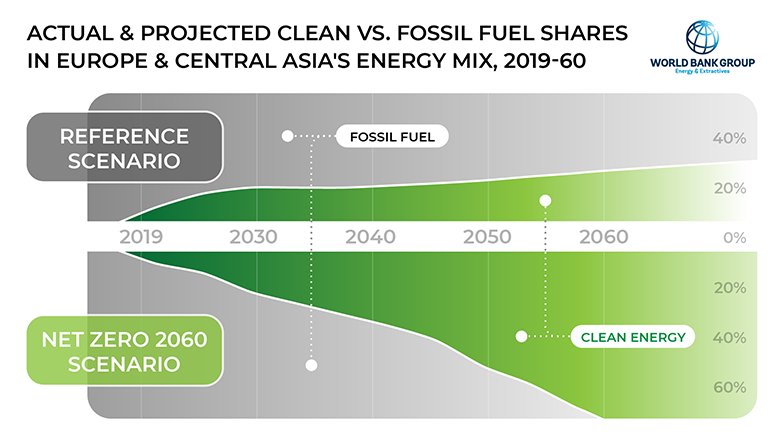About the Report
This report analyzes how governments in the emerging market and developing economies of Europe and Central Asia can prioritize the policies and investments necessary to shift their energy systems away from fossil fuels. Building on a World Bank model, the analysis suggests an optimal least-cost pathway for the region to achieve net zero energy targets by 2060. This approach delivers actionable insights for the region’s energy sector.
DOWNLOAD THE REPORT
Short-Term Imperatives
Europe and Central Asia’s energy system remains vulnerable to natural gas supply shocks and seasonal demand fluctuations. The Western Balkans and Central Asia are especially vulnerable to potential shortages given infrastructure deficits and low levels of cross-border trade.
Gas storage remains an issue across the region. Limited availability of underground gas storage exacerbates exposure to gas supply shocks in parts of the region. Ukraine is an exception with its significant storage capacity having the potential to become a valuable energy security asset for the broader European market.
Subsidies for natural gas and coal are another obstacle to regional energy security and are hindering decarbonization efforts. Reforming subsidies, while protecting the most vulnerable, and investing in energy efficiency can help cut harmful emissions and reduce gas and coal consumption.
Energy Transition
Phasing down coal is a least-cost, no-regrets action essential for the region’s decarbonization and reaching climate goals. As the largest source of fossil fuel–based emissions in the region (excluding Russia), coal represents 42% of all emissions today and will continue to support up to a third of the region’s energy use for decades to come if no action is taken.
The use of natural gas as a source of energy may be on the decline. In a Net Zero 2060 scenario, natural gas will make up 16% of the region’s energy, down from 46% in 2019.
To reach Net-Zero by 2060, the analysis outlines the kinds of investment and action in areas like energy efficiency, new technologies, and energy diversification the region needs to consider:
Energy Mix
- In the World Bank’s Net Zero 2060 scenario, power systems across the region need to emit zero net emissions by 2040, commercial buildings by 2050, and residential buildings by 2055. Hardest to abate, industry and transport sectors will still likely rely on carbon removal technologies such as carbon capture and storage (CCS) for their decarbonization even in 2060.
- With new targets and measures, the share of clean energy in the region’s energy mix could soar from today’s 9% to 75% by 2060.

Energy Efficiency
- Energy consumption can decline by over 40% thanks to energy efficiency, technology advances, and changing behavior, in the Net Zero 2060 scenario. Energy efficiency is one of the key measures that keeps energy consumption in check in the face of growing need for electricity; it also helps reduce the unpredictability of energy bills during the transition.
Technology and Investment
- Thanks to abundant renewables potential, new green technologies that can accelerate the transition in the next decade are either already cost-effective (solar, wind, batteries, EVs, heat pumps) or expected to become cost-effective in this region.
- New and less mature technologies like hydrogen and carbon removal need to advance significantly. By 2060, clean hydrogen could make up 10-13% of the region’s energy use, particularly in industry and transportation. But this will require higher carbon prices or subsidies.
- Achieving Net Zero Energy 2060 target requires an investment of $4.7 trillion (3.9% of regional GDP). However, without more and new targeted measures, only a fraction of required investments will flow into low-carbon technologies.
